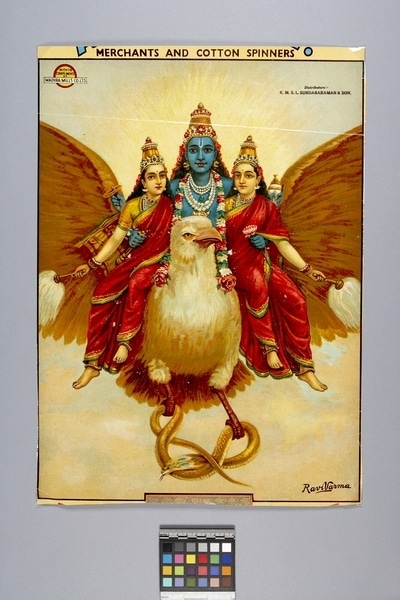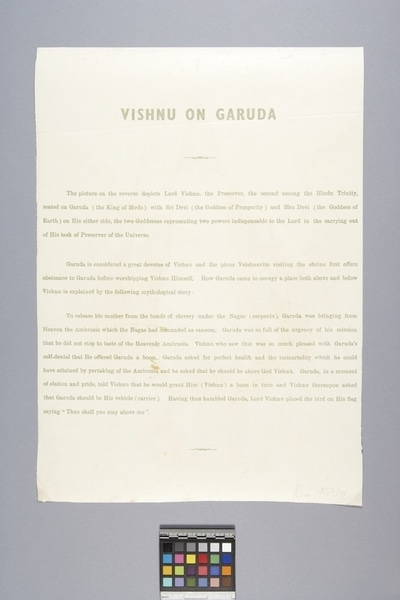Calendar Item Number: Eg236 from the MOA: University of British Columbia


Description
Rectangular calendar print depicting Vishnu, a four-armed male, with two dark haired females each in red saris. All are seated on the back of flying bird with cobra in talons. Bird's outstretched wings are orange-brown. All three of the figures are adorned with jewelled gold crowns, earrings, bracelets and anklets. Vishnu has a striped floral garland around neck. He holds an object in each of his four hands: gold ringed white conch shell, gold disk on index finger, pink lotus and gold mace. His bottom arms are also grasping the females around their waists. Females each carry gold handled, white flying whisk in outstretched outside arm. Light orange, yellow and blue ground. Printed at top "merchants and cotton spinners"; artist's signature at base.
History Of Use
Indian popular religious prints have been published for nearly a century, first by German presses, later by Indian ones. The prints may take the form of calendars, posters, or simply images. The style of the representations is European. In the beginning they were Hindu images, but are now acquiring elements both of folk art and a romantic secularism. It is a living art currently influenced by the movie industry and non-Hindu religions. The images are a vehicle for advertising and are also used for religious purposes. Although painted by Raja Ravi Varma in the 1890s, this reproduction was printed in the 1940s and used in a calendar distributed by A. & F. Harvey Madura Mills Company.
Cultural Context
calendar art; popular religious art
Iconographic Meaning
Vishnu, preserver of the universal order, establishes law and order and protects the world from evil and destruction through ten earthly incarnations. He is identified by: rotating discus; six-petaled lotus; mace symbolizing his power of knowledge; white conch shell; gold crown; and his flying mount, Garuda. In this print, he is identified with his two consorts, Sri Devi and Bhu Devi.
Item History
- Made by Ravi Varma (Maker) in Kerala, India during 1940
- Collected between 1974 and 1982
- Owned by Stephen Inglis before January 1983
- Received from Stephen Inglis (Donor) during January 1983
What
- Name
- Calendar
- Identification Number
- Eg236
- Type of Item
- calendar
- Overall
- height 49.0 cm, width 34.9 cm
Who
- Culture
- South India
- Creator
- Ravi Varma (Maker)
- Previous Owner
- Stephen Inglis
- Received from
- Stephen Inglis (Donor)
Where
- Holding Institution
- MOA: University of British Columbia
- Made in
- Kerala, India
When
- Creation Date
- during 1940
- Collection Date
- between 1974 and 1982
- Ownership Date
- before January 1983
- Acquisition Date
- during January 1983
Other
- Item Classes
- works on paper
- Condition
- good
- Accession Number
- 0857/0091